Lift heavy, live healthy: Proandrogenic strength training.
Lift heavy, live healthy: Proandrogenic strength training.
The Impact of Weight and Strength Training on Testosterone and Hormone Levels
A Science-Backed Overview
The relationship between exercise and hormonal balance has garnered increasing attention within the scientific community but is often overlooked in the broader health, wellness, and longevity sectors. Among various forms of physical activity, weight and strength training have been extensively studied for their impact on hormone levels, particularly testosterone. Testosterone is pivotal in muscle growth, fat distribution, bone density, and overall physical and mental health.
Weight and strength training are fundamental components of the Androgenic Approach to addressing low testosterone levels and enhancing overall quality of life, health, and longevity. This approach comprises a triad of interconnected elements: physical, mental, emotional, and internal health. At its core, weight and strength training underpin the physical aspect.
This guide provides an evidence-based overview of how weight and strength training influence testosterone and other hormone levels. It also explores the critical role of sleep in weight training and testosterone production, and how these factors collectively improve cortisol levels, thereby reinforcing the Androgenic Approach by reducing stress and promoting mental health.
Table of Contents
Training for Growth Hormone and Insulin-like Growth Factor-1
Training for Cortisol and the Testosterone-to-Cortisol Ratio
Sleep is the Foundational Ingredient for Testosterone Production
Building a Proandrogenic Weight and Strength Training Program
Onboarding Program for Proandrogenic Strength and Weight Training
Sample Onboarding Program for Proandrogenic Strength and Weight Training
Training for Testosterone
Testosterone is crucial for both men and women, significantly affecting muscle growth, fat distribution, bone density, and overall physical and mental health. Weight and strength training have been extensively studied for their impact on testosterone levels. Regular resistance training helps manage testosterone levels and enhances overall quality of life, health, and longevity
Resistance Training Promotes Testosterone Production
Numerous studies have demonstrated that resistance training can acutely increase testosterone levels. For instance, Kraemer et al. (1990) found that high-intensity resistance exercise significantly increased serum testosterone levels in both young and older men. The intensity and volume of the exercise were key factors, with higher intensity and larger muscle group involvement leading to greater increases in testosterone.
Similarly, Ahtiainen et al. (2003) reported elevated testosterone levels immediately after heavy resistance training sessions in both trained and untrained men, indicating that resistance training can boost testosterone levels regardless of one's training status. Exercises like squats and bench presses, which engage large muscle groups and require substantial effort, elicited strong hormonal responses.
The Role of Testosterone in Muscle Hypertrophy
Testosterone plays a vital role in muscle hypertrophy, the process of muscle fiber growth and increase in muscle mass. Higher testosterone levels enhance protein synthesis, a key mechanism for muscle repair and growth post-resistance training. Testosterone also stimulates the production of growth hormone (GH), further supporting muscle growth and recovery.
Bhasin et al. (1996) demonstrated that testosterone supplementation combined with resistance training significantly increased muscle size and strength compared to resistance training alone, highlighting the synergistic effect of testosterone on muscle hypertrophy. Higher levels of endogenous testosterone were associated with greater muscle fiber hypertrophy in response to resistance training (Sinha-Hikim et al., 2002), underscoring the importance of maintaining optimal testosterone levels for maximizing muscle-building benefits.
Mechanism of Action: The Testosterone Response to Resistance Training
The mechanisms behind the elevations of testosterone in response to resistance training are multifaceted. High-intensity exercises involving large muscle groups and multiple joints, such as squats, deadlifts, and bench presses, generate significant metabolic stress and mechanical tension. These factors stimulate the hypothalamus and pituitary gland to release luteinizing hormone (LH), which signals the testes to produce more testosterone. It is crucial to emphasize exercises involving large muscle groups and multiple joints, as they are key in maximizing the testosterone response via LH spikes during resistance training.
Additionally, resistance training induces acute increases in blood lactate levels, correlating with higher post-exercise testosterone levels. The combination of mechanical tension, muscle damage, and metabolic stress creates an optimal environment for acute testosterone release, promoting muscle growth and recovery. Testosterone gains occur not only during exertion but also afterward.
Additional Benefits of Increased Testosterone Levels
The benefits of increased testosterone extend beyond physical health. Higher testosterone levels are associated with improved mood, better energy levels, and enhanced cognitive function. Testosterone has been linked to increased motivation and reduced symptoms of depression and anxiety, contributing to better mental health and overall well-being.
Elevated testosterone levels also improve cardiovascular health by enhancing lipid profiles, reducing body fat, and increasing muscle mass, leading to better metabolic health and reduced risk factors for cardiovascular diseases. By adopting a consistent weight and strength training regimen, individuals can experience comprehensive health benefits, contributing to a higher quality of life.
Training for Growth Hormone and Insulin-like Growth Factor-1
Resistance training significantly impacts other anabolic hormones, such as growth hormone (GH) and insulin-like growth factor-1 (IGF-1). In symphony with testosterone, these hormones play crucial roles in muscle growth, repair, and overall physical development, making them essential for a comprehensive approach to improving hormonal health through exercise.
Resistance Training Promotes Growth Hormone Production
Growth hormone (GH) stimulates tissue growth, protein synthesis, and fat metabolism. It is released in pulses, with substantial releases during deep sleep and intense physical activity. High-intensity resistance training markedly elevates GH levels, creating an optimal environment for muscle growth and recovery.
Kraemer et al. (1999) demonstrated that GH levels significantly increased after heavy resistance exercise, with levels peaking immediately post-workout and remaining elevated for several hours. This prolonged anabolic state benefits muscle hypertrophy and fat loss.
The Role of Insulin-like Growth Factor-1 in Muscle Hypertrophy
Insulin-like growth factor-1 (IGF-1), produced in the liver in response to Growth hormone (GH) stimulation, plays a vital role in muscle hypertrophy by promoting protein synthesis and inhibiting protein degradation. It acts directly on muscle cells to enhance growth and repair processes, making it essential for building muscle and improving physical performance.
Kraemer et al. (1999) observed corresponding increases in IGF-1 levels following heavy resistance exercise. The elevated GH levels stimulated IGF-1 production, which remained elevated for several hours post-exercise, supporting ongoing muscle repair and growth.
Mechanism of Action: The Testosterone-to-Cortisol Ratio Response to Resistance Training
As with testosterone, the mechanisms behind GH and IGF-1 elevations in response to resistance training are multifaceted. High-intensity exercises involving large muscle groups and multiple joints generate significant metabolic stress and mechanical tension, stimulating the hypothalamus and pituitary gland to release GH, which in turn stimulates the liver to produce IGF-1. Muscle microtrauma from resistance training activates satellite cells essential for muscle repair and growth, with GH and IGF-1 playing pivotal roles in regulating satellite cell activity.
Additional Benefits of Increased Growth Hormone and Insulin-like Growth Factor-1 Levels
The benefits of increased growth hormone (GH) and insulin-like growth factor-1 (IGF-1) extend beyond muscle growth and recovery. Elevated levels of these hormones are associated with improved body composition, enhanced bone density, and better overall physical and mental health. Higher levels of GH and IGF-1 contribute to improved fat metabolism and protein synthesis, leading to a reduction in body fat and an increase in lean muscle mass (Huang et al., 2020). This shift in body composition enhances physical appearance and metabolic health, reducing the risk of obesity-related conditions such as type 2 diabetes and cardiovascular disease (Matafome & Seiça, 2017). GH and IGF-1 also improve bone density by promoting the formation of new bone tissue and supporting joint health through the repair and regeneration of cartilage, thereby reducing the risk of osteoporosis, fractures, and degenerative joint diseases (Wydra et al., 2023).
In addition, GH and IGF-1 play crucial roles in enhancing immune function, cognitive abilities, and cardiovascular health. They stimulate the production and activity of immune cells, improving the body's defense against infections and diseases (Devesa et al., 2016). Higher levels of these hormones are linked to increased neurogenesis, better memory, and improved mood regulation, reducing symptoms of depression and anxiety (Junnila et al., 2013). GH and IGF-1 also support heart function and vascular health by promoting the repair and regeneration of heart muscle cells and blood vessels, reducing the risk of heart disease (Gola et al., 2005). By adopting a consistent weight and strength training regimen, individuals can experience comprehensive health benefits from increased GH and IGF-1 levels, contributing to a higher quality of life.
Training for Cortisol and the Testosterone-to-Cortisol Ratio
Cortisol, a catabolic hormone, plays a significant role in the body's response to stress, including intense exercise. While acute increases in cortisol levels are typical post-high-intensity resistance training, reflecting the body's immediate stress response, the testosterone-to-cortisol ratio (T/C ratio) is crucial for understanding overall hormonal balance.
Resistance Training Promotes Improved Testosterone-to-Cortisol Ratios
The testosterone-to-cortisol ratio (T/C ratio) is a marker of the balance between anabolic (muscle-building) and catabolic (muscle-degrading) processes. An optimal T/C ratio indicates a favorable environment for muscle growth and recovery. Research indicates that resistance training can improve the T/C ratio, suggesting that the anabolic effects of increased testosterone outweigh the catabolic effects of cortisol.
Hakkinen et al. (1987) found that while cortisol levels rose significantly post-exercise, the overall T/C ratio improved, indicating enhanced anabolic potential. Resistance training helps maintain or improve this balance, promoting muscle hypertrophy and recovery despite temporary cortisol increases.
Mechanism of Action: How Testosterone-to-Cortisol Ratio Response to Resistance Training
Cortisol is released by the adrenal glands in response to physical stress, such as high-intensity resistance training, helping mobilize energy stores by increasing glucose availability. However, elevated cortisol levels over prolonged periods can lead to muscle breakdown and impaired recovery, emphasizing the importance of managing cortisol effectively.
Resistance training, especially at high intensities, induces a temporary spike in cortisol levels. This acute response is part of the body's natural adaptation process, fueling the workout and initiating tissue repair. However, chronic elevation of cortisol can be detrimental, highlighting the need for a balanced approach to training and recovery.
Outside of the Gym: Improving the Testosterone-to-Cortisol Ratio
To optimize the testosterone-to-cortisol ratio (T/C ratio), it is crucial to manage cortisol levels effectively. Here are strategies to mitigate the catabolic effects of cortisol and enhance the anabolic benefits of resistance training:
- Adequate Rest and Recovery: Ensure sufficient rest between training sessions to prevent chronic cortisol elevation. Incorporate rest days and prioritize sleep to maintain an optimal T/C ratio. Aim for 7-9 hours of quality sleep per night.
- Proper Nutrition: A balanced diet rich in essential nutrients supports the body's ability to manage stress and sustain anabolic processes. Consuming adequate protein, healthy fats, and complex carbohydrates can stabilize blood sugar levels and reduce cortisol production. Include foods high in antioxidants and anti-inflammatory properties, such as fruits, vegetables, and omega-3 fatty acids.
- Stress Management Techniques: Implementing stress management techniques such as meditation, mindfulness, yoga, and deep breathing exercises can reduce overall stress and cortisol levels, promoting relaxation and recovery.
- Periodization of Training: Structured training programs with variations in intensity, volume, and rest periods can prevent overtraining and chronic cortisol elevation. Periodization allows for planned recovery phases, ensuring the body has sufficient time to adapt and recover from high-intensity workouts.
Additional Benefits of Improved Testosterone-to-Cortisol Ratios
An optimized testosterone-to-cortisol ratio (T/C ratio) offers significant benefits beyond muscle growth and recovery. A favorable T/C ratio is linked to enhanced physical performance, as it indicates a better balance between anabolic and catabolic processes. This balance supports greater muscle hypertrophy and strength gains while minimizing muscle breakdown and fatigue (Hakkinen et al., 1987). Moreover, an optimal T/C ratio contributes to improved endurance and reduced risk of overtraining, allowing athletes to maintain high levels of performance over extended periods.
Additionally, a balanced T/C ratio positively impacts mental health and overall well-being. Elevated cortisol levels, particularly when chronic, are associated with increased stress, anxiety, and impaired cognitive function. By managing cortisol levels through effective training and recovery strategies, individuals can experience better mood regulation, reduced symptoms of anxiety, and enhanced cognitive abilities. This holistic approach to training not only promotes physical health but also fosters mental resilience and overall quality of life.
Sleep is the Foundational Ingredient for Testosterone Production
Sleep is critical for recovery from weight and strength training and the regulation of testosterone production. During sleep, the body undergoes numerous restorative processes essential for muscle repair, growth, and overall hormonal balance. Inadequate sleep significantly impairs recovery and reduces the anabolic effects of resistance training.
Dattilo et al. (2011) highlighted that sleep deprivation leads to increased cortisol levels and reduced testosterone production, negatively impacting muscle recovery and growth. This underscores the importance of both sleep duration and quality in maximizing the benefits of resistance training. Optimal sleep helps lower cortisol levels, improving the T/C ratio and enhancing the anabolic environment necessary for muscle hypertrophy.
Leproult and Van Cauter (2011) demonstrated that sleep restriction significantly decreases daytime testosterone levels in healthy young men. Reducing sleep duration to five hours per night for one week resulted in a 10-15% reduction in daytime testosterone levels, highlighting the importance of adequate sleep for maintaining optimal hormonal balance.
To maximize the benefits of resistance training and support testosterone production, prioritize sleep. Aim for 7-9 hours of quality sleep per night. Implement good sleep hygiene practices, such as maintaining a consistent sleep schedule, creating a relaxing bedtime routine, and ensuring a comfortable sleep environment. Prioritizing restorative sleep enhances hormonal health, supports muscle growth, and optimizes overall well-being.
Building a Proandrogenic Weight and Strength Training Program
Foundational Exercises for Increasing Testosterone Production
Compound movements are multi-joint exercises that engage large muscle groups, making them particularly effective for stimulating testosterone production. These exercises demand significant energy and muscle activation, leading to a robust hormonal response. Incorporating the following key compound movements into your workout routine can help maximize testosterone levels and overall strength gains.
Squats
Why Squats?
Squats are highly effective for stimulating testosterone production. This foundational compound movement engages the quadriceps, hamstrings, glutes, and core muscles. Squats promote overall lower body strength and stability while also enhancing metabolic and hormonal responses, making them an essential exercise in strength training programs.
How to Perform a Squat
- Stand with feet shoulder-width apart.
- Hold a barbell across your upper back or keep hands at your sides if using body weight.
- Lower your body by bending your knees and hips, keeping your chest up and back straight.
- Descend until thighs are parallel to the ground or lower.
- Push through your heels to return to the starting position.
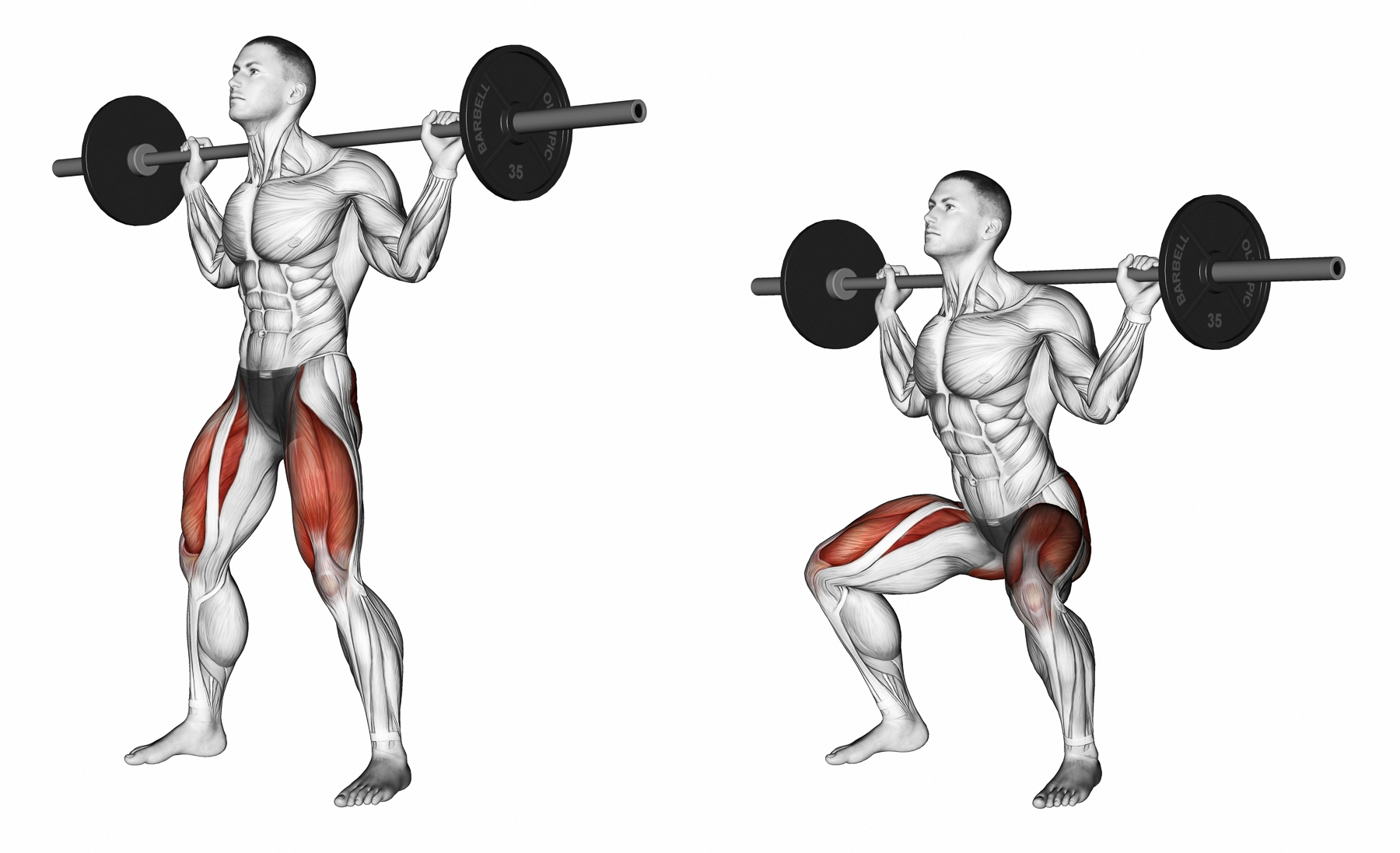
Tips for Maximum Benefit
- Ensure proper form to avoid injury and maximize muscle activation. Perform squats with heavy weights and low repetitions for maximum testosterone boost (Fry et al., 2011).
Deadlifts
Why Deadlifts?
Deadlifts target the entire posterior chain, including the hamstrings, glutes, lower back, and upper back. This compound movement is essential for building overall strength and muscle mass, promoting functional fitness by mimicking everyday movements. Deadlifts also stimulate significant metabolic and hormonal responses, making them a cornerstone of effective strength training programs.
How to Perform Deadlifts
- Stand with feet hip-width apart, with a barbell over your mid-foot.
- Bend at your hips and knees to grasp the bar with an overhand grip.
- Keep your back straight and chest up as you lift the bar by straightening your hips and knees.
- Stand tall with shoulders back at the top of the movement.
- Lower the bar back to the ground with control.
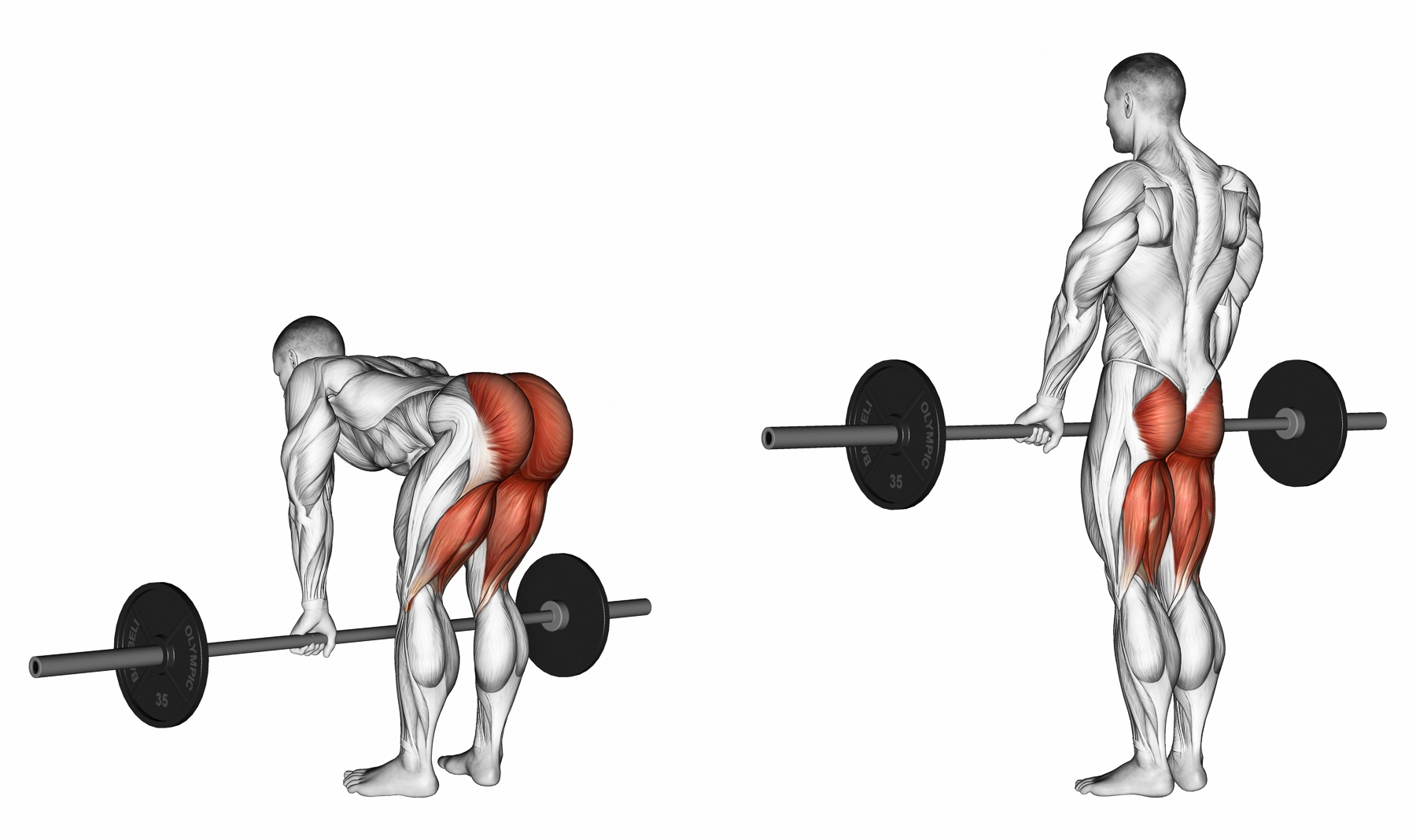
Tips for Maximum Benefit
- Use heavy weights and focus on maintaining proper form. Deadlifts elicit substantial increases in testosterone and growth hormone levels (Hakkinen and Pakarinen, 1993).
Bench Press
Why Bench Press?
The bench press is a compound movement that primarily targets the pectoral muscles, triceps, and shoulders. This exercise is integral to strength training programs due to its ability to engage multiple muscle groups simultaneously, promoting overall upper body strength and muscular development.
How to Perform the Bench Press
- Lie on a bench with feet flat on the floor.
- Grip the barbell with hands slightly wider than shoulder-width apart.
- Lower the barbell to your chest, keeping elbows at a 45-degree angle.
- Push the barbell back up to the starting position.
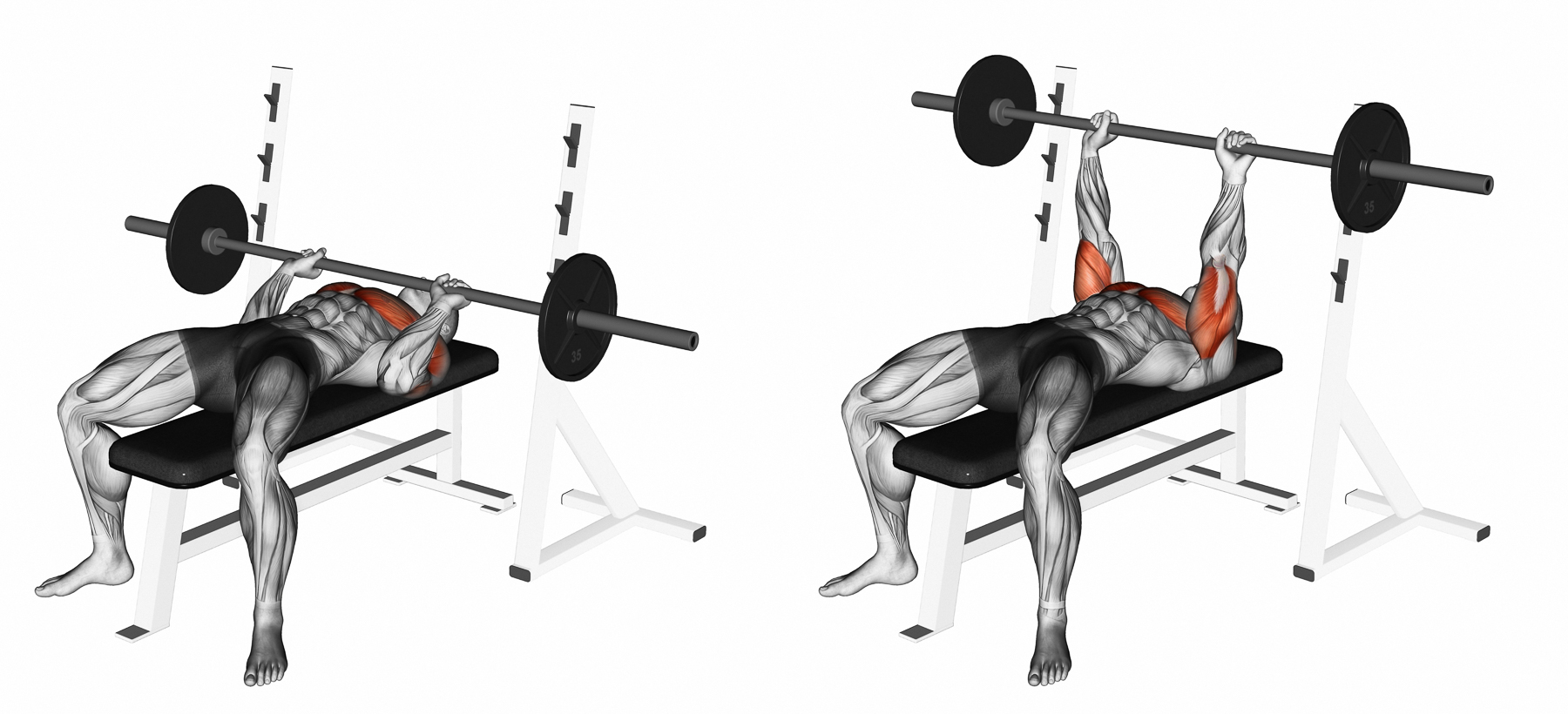
Tips for Maximum Benefit
- Use a weight that allows you to perform 3-5 repetitions with good form. Perform the bench press with heavy weights and high intensity for increased testosterone production.
Pull-Ups and Chin-Ups
Why Pull-Ups and Chin-Ups?
Pull-ups and chin-ups primarily target the upper body, engaging the latissimus dorsi, biceps, and shoulders. These bodyweight exercises are excellent for building upper body strength and muscle definition while also enhancing grip strength and overall functional fitness.
How to Perform Pull-Ups and Chin-Ups
- Grip the pull-up bar with hands shoulder-width apart (pull-ups) or with palms facing you (chin-ups).
- Hang with arms fully extended.
- Pull your body up until your chin is above the bar.
- Lower yourself back to the starting position with control.
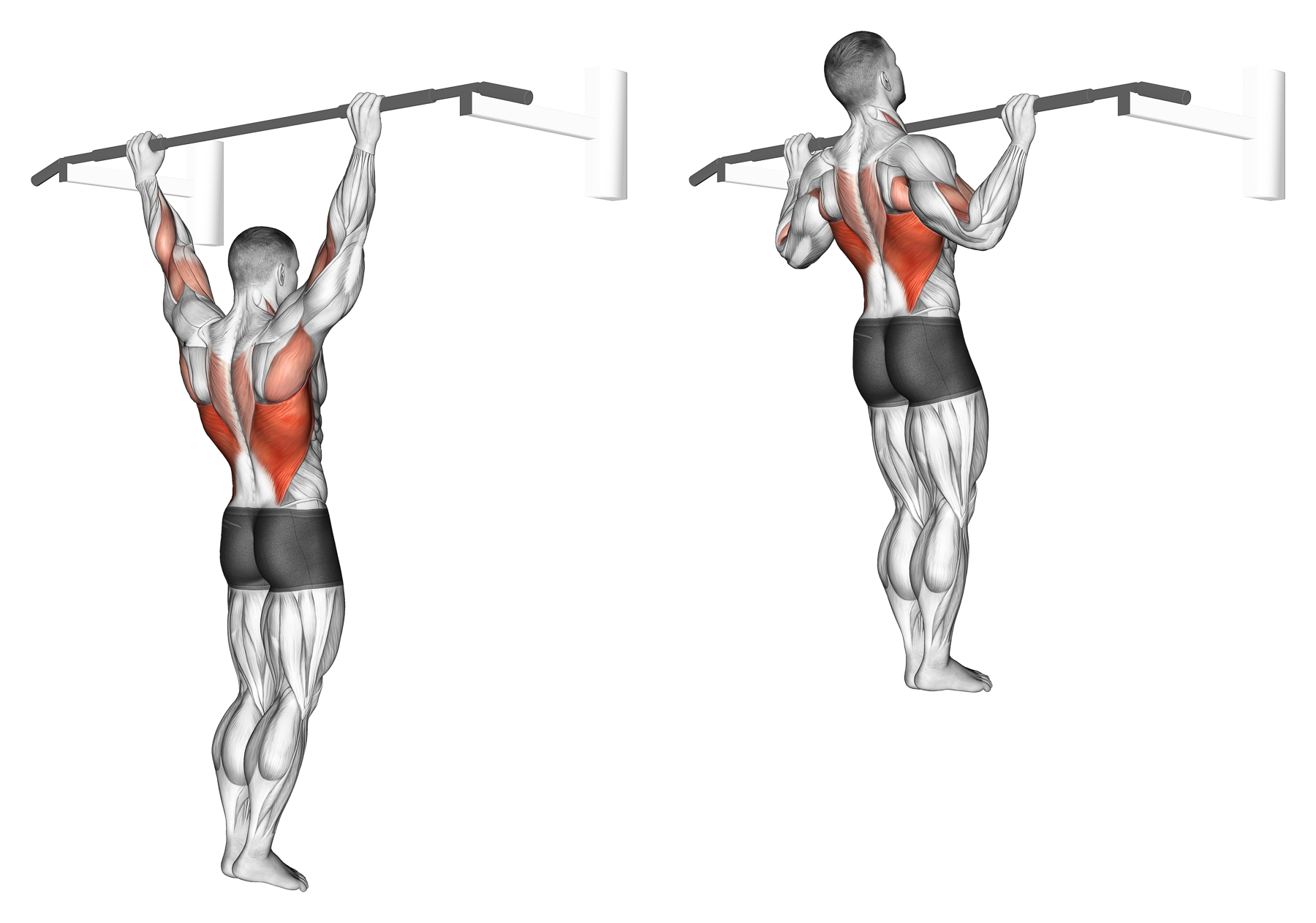
Tips for Maximum Benefit
- Add weight using a belt or weighted vest to increase intensity. High-intensity and muscle recruitment during pull-ups and chin-ups can significantly stimulate testosterone production.
Rows
Why Rows?
Rowing exercises, such as barbell rows and seated rows, engage the back, shoulders, and arms. These movements are crucial for developing upper body strength and improving posture, as they target key muscles in the upper and middle back. Rows also enhance overall functional fitness by mimicking natural pulling movements.
How to Perform Barbell Rows
- Stand with feet shoulder-width apart, holding a barbell with an overhand grip.
- Bend at your hips and knees, keeping your back straight and chest up.
- Pull the barbell towards your lower ribcage, squeezing your shoulder blades together.
- Lower the barbell back to the starting position with control.
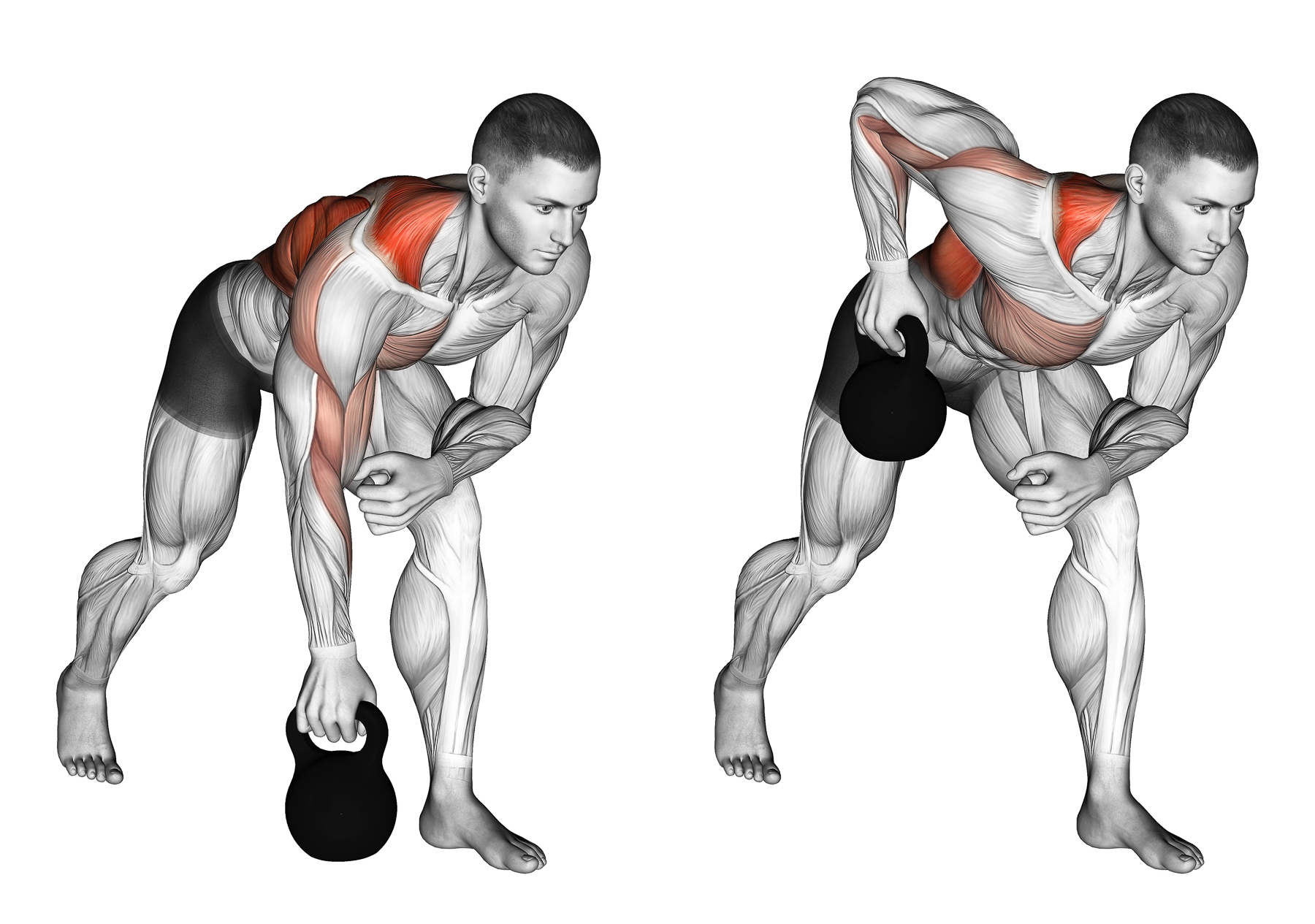
Tips for Maximum Benefit
- Focus on maintaining a straight back and controlled movement. Rows stimulate significant hormonal responses that support muscle growth and overall strength development.
Sample Onboarding Program for Proandrogenic Strength and Weight Training
A 6-Week Program for Implementing Proandrogenic Strength and Weight Training
Overview: This program is designed to increase testosterone levels through high-intensity resistance training involving large muscle groups and compound movements. Training occurs three days per week, focusing on squats, deadlifts, bench press, pull-ups, and rows. Each week progressively increases intensity and volume to maximize hormonal response and muscle growth
This structured approach maximizes testosterone production and overall hormonal health, leading to improved muscle growth, strength, and well-being.
Onboarding for Proandrogenic Strength and Weight Training |
||||
|---|---|---|---|---|
| Week | Day | Exercise | Sets | Reps/Duration |
| Week 1-2: Foundation Phase | Day 1 | Squats | 3 | 8-10 |
| Bench Press | 3 | 8-10 | ||
| Pull-Ups | 3 | To failure | ||
| Plank | 3 | 30-45 seconds | ||
| Day 2 | Deadlifts | 3 | 8-10 | |
| Rows (Barbell Rows) | 3 | 8-10 | ||
| Dumbbell Shoulder Press | 3 | 10 | ||
| Hanging Leg Raises | 3 | 10-12 | ||
| Day 3 | Squats | 3 | 6-8 | |
| Bench Press | 3 | 6-8 | ||
| Chin-Ups | 3 | To failure | ||
| Side Plank | 3 | 30 seconds each side | ||
| Week 3-4: Intensity Phase | Day 1 | Squats | 4 | 6-8 |
| Bench Press | 4 | 6-8 | ||
| Pull-Ups | 4 | To failure | ||
| Plank | 3 | 45-60 seconds | ||
| Day 2 | Deadlifts | 4 | 6-8 | |
| Rows (Barbell Rows) | 4 | 6-8 | ||
| Dumbbell Shoulder Press | 4 | 8 | ||
| Hanging Leg Raises | 4 | 10-12 | ||
| Day 3 | Squats | 4 | 4-6 | |
| Bench Press | 4 | 4-6 | ||
| Chin-Ups | 4 | To failure | ||
| Side Plank | 4 | 30 seconds each side | ||
| Week 5-6: Peak Phase | Day 1 | Squats | 5 | 4-6 |
| Bench Press | 5 | 4-6 | ||
| Pull-Ups | 5 | To failure | ||
| Plank | 4 | 60 seconds | ||
| Day 2 | Deadlifts | 5 | 4-6 | |
| Rows (Barbell Rows) | 5 | 4-6 | ||
| Dumbbell Shoulder Press | 5 | 6 | ||
| Hanging Leg Raises | 5 | 10-12 | ||
| Day 3 | Squats | 5 | 3-5 | |
| Bench Press | 5 | 3-5 | ||
| Chin-Ups | 5 | To failure | ||
| Side Plank | 4 | 45 seconds each side | ||
Additional Guidelines |
|
|---|---|
| Guideline | Details |
| Warm-Up | Begin each session with a 5-10 minute warm-up, including dynamic stretches and light cardio to prepare the body for exercise. |
| Rest | Allow 1-2 minutes of rest between sets for compound movements to ensure adequate recovery and maintain high intensity. |
| Progressive Overload | Increase weights progressively each week while maintaining proper form to ensure continued muscle adaptation and growth. |
| Sleep | Prioritize 7-9 hours of quality sleep per night to optimize recovery and hormonal balance. |
| Nutrition | Maintain a balanced diet rich in protein, healthy fats, and complex carbohydrates to support muscle repair and growth. Include foods high in antioxidants and anti-inflammatory properties to aid recovery. |
Final Thoughts
Understanding the hormonal responses to resistance training is crucial for optimizing training programs for muscle growth, recovery, and overall health. Acute spikes in testosterone and GH following weight and strength training sessions promote muscle protein synthesis and tissue repair. Additionally, the improved T/C ratio suggests that resistance training can help maintain a balance between anabolic and catabolic processes, essential for long-term muscle health and performance.
Adequate sleep is indispensable, supporting recovery and sustaining the hormonal environment necessary for muscle growth and overall well-being. Incorporating compound movements into training routines can maximize these hormonal benefits, leading to enhanced strength and hypertrophy.
Weight and strength training are effective for acutely increasing testosterone and other anabolic hormones, such as GH and IGF-1. These hormonal responses play significant roles in muscle growth, recovery, and overall physical health. While the long-term effects on resting testosterone levels require further investigation, the acute hormonal responses to resistance exercise underscore the importance of incorporating strength training into fitness routines for optimal hormonal health. Ensuring adequate sleep is essential to maximize the benefits of resistance training on hormonal balance and muscle recovery. Incorporating compound movements into training programs can further enhance testosterone production and overall training outcomes.
Further Reading and Resources
Selected References and Citations
Ahtiainen, J. P., Pakarinen, A., Alen, M., Kraemer, W. J., & Häkkinen, K. (2003). Muscle hypertrophy, hormonal adaptations and strength development during strength training in strength-trained and untrained men. European Journal of Applied Physiology, 89(6), 555–563. https://doi.org/10.1007/s00421-003-0833-3
Dattilo, M., Antunes, H. K., Medeiros, A., Mônico Neto, M., Souza, H. S., Tufik, S., & de Mello, M. T. (2011). Sleep and muscle recovery: endocrinological and molecular basis for a new and promising hypothesis. Medical Hypotheses, 77(2), 220–222. https://doi.org/10.1016/j.mehy.2011.04.017
Devesa, J., Almengló, C., & Devesa, P. (2016). Multiple effects of growth hormone in the body: Is it really the hormone for growth? Clinical Medicine Insights: Endocrinology and Diabetes, 9, 47–71. https://doi.org/10.4137/CMED.S38201
Fry, A. C., & Kraemer, W. J. (1997). Resistance exercise overtraining and overreaching. Neuroendocrine responses. Sports Medicine (Auckland, N.Z.), 23(2), 106–129. https://doi.org/10.2165/00007256-199723020-00004
Gola, M., Bonadonna, S., Doga, M., & Giustina, A. (2005). Clinical review: Growth hormone and cardiovascular risk factors. The Journal of Clinical Endocrinology and Metabolism, 90(3), 1864–1870. https://doi.org/10.1210/jc.2004-0545
Griggs, R. C., Kingston, W., Jozefowicz, R. F., Herr, B. E., Forbes, G., & Halliday, D. (1989). Effect of testosterone on muscle mass and muscle protein synthesis. Journal of Applied Physiology (Bethesda, Md.: 1985), 66(1), 498–503. https://doi.org/10.1152/jappl.1989.66.1.498
Häkkinen, K., & Pakarinen, A. (1991). Serum hormones in male strength athletes during intensive short term strength training. European Journal of Applied Physiology and Occupational Physiology, 63(3-4), 194–199. https://doi.org/10.1007/BF00233847
Häkkinen, K., Pakarinen, A., Alén, M., Kauhanen, H., & Komi, P. V. (1988). Neuromuscular and hormonal responses in elite athletes to two successive strength training sessions in one day. European Journal of Applied Physiology and Occupational Physiology, 57(2), 133–139. https://doi.org/10.1007/BF00640652
Huang, Z., Huang, L., Waters, M. J., & Chen, C. (2020). Insulin and growth hormone balance: Implications for obesity. Trends in Endocrinology and Metabolism: TEM, 31(9), 642–654. https://doi.org/10.1016/j.tem.2020.04.005
Junnila, R. K., List, E. O., Berryman, D. E., Murrey, J. W., & Kopchick, J. J. (2013). The GH/IGF-1 axis in ageing and longevity. Nature Reviews Endocrinology, 9(6), 366–376. https://doi.org/10.1038/nrendo.2013.67
Kraemer, W. J., Fleck, S. J., Dziados, J. E., Harman, E. A., Marchitelli, L. J., Gordon, S. E., Mello, R., Frykman, P. N., Koziris, L. P., & Triplett, N. T. (1993). Changes in hormonal concentrations after different heavy-resistance exercise protocols in women. Journal of Applied Physiology (Bethesda, Md.: 1985), 75(2), 594–604. https://doi.org/10.1152/jappl.1993.75.2.594
Kraemer, W. J., Volek, J. S., Clark, K. L., Gordon, S. E., Puhl, S. M., Koziris, L. P., McBride, J. M., Triplett-McBride, N. T., Putukian, M., Newton, R. U., Häkkinen, K., Bush, J. A., & Sebastianelli, W. J. (1999). Influence of exercise training on physiological and performance changes with weight loss in men. Medicine and Science in Sports and Exercise, 31(9), 1320–1329. https://doi.org/10.1097/00005768-199909000-00014
Leproult, R., & Van Cauter, E. (2011). Effect of 1 week of sleep restriction on testosterone levels in young healthy men. JAMA, 305(21), 2173–2174. https://doi.org/10.1001/jama.2011.710
Matafome, P., & Seiça, R. (2017). The role of brain in energy balance. Advances in Neurobiology, 19, 33–48. https://doi.org/10.1007/978-3-319-63260-5_2
Nindl, B. C., Kraemer, W. J., Marx, J. O., Arciero, P. J., Dohi, K., Kellogg, M. D., & Loomis, G. A. (2001). Overnight responses of the circulating IGF-I system after acute, heavy-resistance exercise. Journal of Applied Physiology (Bethesda, Md.: 1985), 90(4), 1319–1326. https://doi.org/10.1152/jappl.2001.90.4.1319
Wydra, A., Czajka-Oraniec, I., Wydra, J., & Zgliczyński, W. (2023). The influence of growth hormone deficiency on bone health and metabolism. Reumatologia, 61(4), 239–247. https://doi.org/10.5114/reum/170244
Viru, A., & Viru, M. (2001). Nature of training effects. In A. Viru & M. Viru (Eds.), Biochemical Monitoring of Sport Training (pp. 1-63). Champaign, IL: Human Kinetics.
Site Disclaimers
General Guidence
The content on this site is provided for educational and informational purposes only and should not be construed as medical advice. Always consult a qualified healthcare provider before making changes to your diet, lifestyle, or health regimen, particularly if you are pregnant or nursing, under the age of 18, managing allergies or known sensitivities, or living with any medical conditions.
At RAW Forest Foods, your safety is our priority. Please note that our products are dietary supplements, not medications. The following disclaimer applies:
* These statements have not been evaluated by the Food and Drug Administration. These products are not intended to diagnose, treat, cure, or prevent any disease.
Ingredient Transparency and Allergen Awareness
We are committed to providing transparent ingredient information to help you make informed decisions. If you have or suspect you have allergies to any of our ingredients, we strongly advise against using our products, as allergic reactions can be severe.
Interaction with Medications
If you are taking any medications, consult with your healthcare provider before using supplements. Certain supplements may interact with medications, potentially altering their effectiveness or causing unwanted effects.
For more details, please review our full Terms and Conditions.